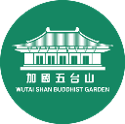Audio 0015 English
Amituofo! Before us is a small red shrine, dedicated to the local protector deities of Wutai Shan, known in Chinese as: the Tudigong.
While this shrine might not seem as magnificent as the other sacred places of Wutai Shan, it is still the most luxurious Tudigong shrine in North America. Traditional Tudigong shrines are often very small, with many having no building at all.
Why do we worship the Tudigong? The belief in Earth deities has a long history and has already become deeply ingrained in our daily lives.
There are many ancient myths and novels that reference the Tudigong. For example, in Journey to the West, as Tang Sanzang and his disciples travel to the Western Paradise to obtain Buddhist scriptures, Sun Wukong summons the Tudigong of each location to learn about its ecosystem. This shows the close relationship that nature deities have to our daily lives.
In Buddhism, the Tudigong is referred to as the "Steadfast Earth God," and there are records of the Steadfast Earth God in various Mahayana sutras. For instance, in the twenty-first chapter of the Lalitavistara Sutra (“Subduing The Demons”), it is mentioned that when The Buddha first attained enlightenment, a Steadfast Earth God emerged from the ground to bear witness, and respectfully presented a seven-jewelled vase filled with fragrant flowers as an offering to the World-Honoured One. Similarly, in the Sutra of the Past Vows of Earth Store Bodhisattva, The Buddha praises the Steadfast Earth God for nourishing and benefitting all sentient beings.
There is a Tudigong shrine at Wutai Shan because on one hand, workers need to dig up the land for new building projects, potentially harming unseen lifeforms. On the other hand, it is a way to express gratitude for the Tudigong’s silent blessings and protection. Through-out the construction process for Wutai Shan, whether it was excavating Wisdom Lake or digging through soil to build various temple halls, the local Tudigong have provided us with many incredible blessings. In Buddhism, the concept of Dependent Origination is highly valued, and having a shrine for these deities is a way to show appreciation for their assistance in the construction of Wutai Shan Buddhist Garden.
Amituofo! Before us is a small red shrine, dedicated to the local protector deities of Wutai Shan, known in Chinese as: the Tudigong.
While this shrine might not seem as magnificent as the other sacred places of Wutai Shan, it is still the most luxurious Tudigong shrine in North America. Traditional Tudigong shrines are often very small, with many having no building at all.
Why do we worship the Tudigong? The belief in Earth deities has a long history and has already become deeply ingrained in our daily lives.
There are many ancient myths and novels that reference the Tudigong. For example, in Journey to the West, as Tang Sanzang and his disciples travel to the Western Paradise to obtain Buddhist scriptures, Sun Wukong summons the Tudigong of each location to learn about its ecosystem. This shows the close relationship that nature deities have to our daily lives.
In Buddhism, the Tudigong is referred to as the "Steadfast Earth God," and there are records of the Steadfast Earth God in various Mahayana sutras. For instance, in the twenty-first chapter of the Lalitavistara Sutra (“Subduing The Demons”), it is mentioned that when The Buddha first attained enlightenment, a Steadfast Earth God emerged from the ground to bear witness, and respectfully presented a seven-jewelled vase filled with fragrant flowers as an offering to the World-Honoured One. Similarly, in the Sutra of the Past Vows of Earth Store Bodhisattva, The Buddha praises the Steadfast Earth God for nourishing and benefitting all sentient beings.
There is a Tudigong shrine at Wutai Shan because on one hand, workers need to dig up the land for new building projects, potentially harming unseen lifeforms. On the other hand, it is a way to express gratitude for the Tudigong’s silent blessings and protection. Through-out the construction process for Wutai Shan, whether it was excavating Wisdom Lake or digging through soil to build various temple halls, the local Tudigong have provided us with many incredible blessings. In Buddhism, the concept of Dependent Origination is highly valued, and having a shrine for these deities is a way to show appreciation for their assistance in the construction of Wutai Shan Buddhist Garden.
